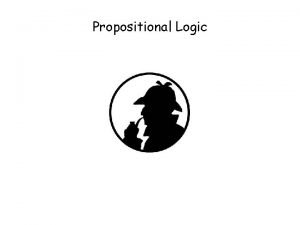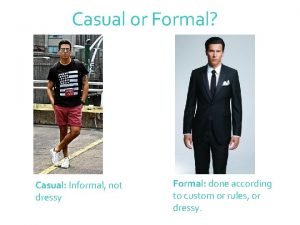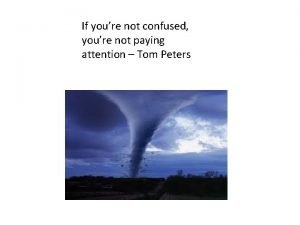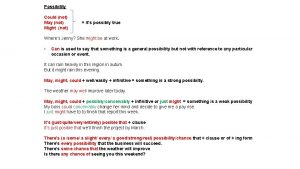How to give an How not to give

















- Slides: 17

How to give an How (not) to give oral an oral presentation prsentation Janet Holmén Freelance editor janet. holmen@gmail. com

What I will cover in this talk the content of your talk adjust the level of your presentation to your intended audience limit the amount of material you present (overall and on each slide) try to maintain consistent design and information layout in your visuals emphasize content rather than special effects you and your presentation style stay calm and speak distinctly use different tones of voice for variety and emphasis avoid distracting listeners from what you are saying interacting with your audience look at listeners all over the auditorium listen carefully to questions and answer them right away – at least briefly respect your listeners' intelligence

level amount design special effects

Who are you talking to? You probably know a lot more about your topic than many of your listeners. If you use terms they don't understand, or assume they know something they don't know, they will get lost, confused – maybe even irritated – and will stop listening. Knowing how much your audience knows is tricky. One way to check if the level of your talk is okay is to try it out on a few people and ask them for feedback.

How much should you present? a lot. . . Obviously you can try to tell your listeners every single fact you know on the topic you have been asked to speak about; after all, you want to show everybody how smart you are. Unfortunately, if you tell people everything you know, the impression they come away with is not that you have unlimited knowledge, but that you have limited ability to identify what is truly important. For this reason, you should focus on just a few themes. You can also try to put every single word you want to say to your audience onto the slides. That way, if you get nervous, all you have to do is read straight from the slides and you won't leave anything out. Another advantage is that you can let your audience have the presentation as a printout or a file and they will have access to all the information, even if you haven't managed to present it in such a way that they could understand or remember what you said. Of course the text may be so small they can't read it. Your audience may want to ask questions at the end, especially if they haven't understood anything. If there is no time for questions, your listeners may leave the auditorium knowing only one thing they didn't know at the beginning of your lecture: you are a poor speaker. or a little. . . �select 1 -3 themes �leave space on slides �leave time for questions �less is more!

Mary Wollstonecraft Shelley FRANKENCOURSE! Tom Kuhlmann WHAT'S THE BEST LAYOUT? Consistent slide design and layout means fewer distractions and less work for the audience

WILL SPECIAL EFFECTS The theme of your talk is interesting (we hope). Special effects may obscure your message rather than enhancing it. Place emphasis on the information itself. KEEP IT INTERESTING?

ABOUT YOU AND YOUR PRESENTATION STYLE Stage fright Using your voice Holding listeners' attention

Nervous? This will happen What you can do � Your voice will crack � Practice your presentation � Your knees will wobble � Check the lecture room and the equipment in advance � You will speak too fast � You will lose your place � You will forget your talk � You will feel awful � But your listeners won't realize you're nervous! � Memorize your first words � Find friendly faces in the audience and talk to them � Savor your successes � Don't apologize!

Master your voice �Speak loud enough (check ahead of time) �Vary your pace �Vary your intonation �Vary your volume �Don't be afraid of brief silences �Look for good models to emulate

AVOID DISTRACTIONS IF AN ELEMENT DOESN'T HELP YOUR AUDIENCE UNDERSTAND YOUR POINT, DON'T INCLUDE IT! one of listen your ers

About interacting with your audience Making eye contact with listeners Taking questions from listeners Respecting listeners

�Eye contact shows your involvement �"Look �Use at every single audience member" friendly faces to help stay calm Look your listeners in the eye

* Listen carefully * Repeat the question before answering * If you had planned to talk about the topic later, answer briefly anyway * Plan a strategy to "kill" questions that aren't relevant to the topic *

They may know less than you You are probably an expert in your field � Graphs and diagrams must be explained � Never say "That's a stupid question" But they are just as intelligent Respect your listeners! � � Watch people's reactions � Imagine that you are speaking to both expert colleagues and laypeople � If they don't understand, it's YOUR fault!

What I will cover in this talk the content of your talk adjust the level of your presentation to your intended audience limit the amount of material you present (overall and on each slide) try to maintain consistent design and information layout in your visuals emphasize content rather than special effects you and your presentation style stay calm and speak distinctly use different tones of voice for variety and emphasis avoid distracting listeners from what you are saying interacting with your audience look at listeners all over the auditorium listen carefully to questions and answer them right away – at least briefly respect your listeners' intelligence

WHAT ELSE HAVE YOU LEARNED?
 Sadlier vocabulary workshop level d unit 1
Sadlier vocabulary workshop level d unit 1 What is the main idea of give me liberty or give me death
What is the main idea of give me liberty or give me death Do not give free flow oxygen through
Do not give free flow oxygen through Do not give what is holy to the dogs
Do not give what is holy to the dogs God did not give
God did not give Paw paw strips in water
Paw paw strips in water If p then q
If p then q You can't improve what you don't measure quote
You can't improve what you don't measure quote P ran
P ran Not casual but not formal
Not casual but not formal Small just
Small just We will not be moved you're standing with us
We will not be moved you're standing with us Attention is not not explanation
Attention is not not explanation Love is not all
Love is not all Not a rustling leaf not a bird
Not a rustling leaf not a bird Not too narrow not too deep
Not too narrow not too deep Ears that hear and eyes that see
Ears that hear and eyes that see If you're not confused you're not paying attention
If you're not confused you're not paying attention

































